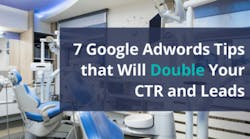7 Google adwords tips that will double your click-through-rate and leads
It's a commitment, but it pays off. With so many patients finding their health-care providers by searching online, dentists need to build their online search presence. Yes, this takes some time, but it is well worth the effort. Here's how to increase your SEO.
This article originally appeared in the Principles of Practice Management e-newsletter. Subscribe to the twice monthly ENL here.
Whether you are a new practice opening your doors for the first time, or a seasoned dentist, Google Adwords will always be beneficial to the success of your practice. Why? Consider this. Dentists with little online presence will not rank in the first page organically, or even second. This is called search engine optimization (SEO).
SEO is a marathon and not a sprint because it takes time for your marketing efforts to come into fruition. It’s like a healthy diet—it takes dedication and a long-term commitment in order to see results, and you must continuously keep doing it to either maintain or keep improving upon those results. Google Adwords is like cosmetic surgery—you pay for immediate results, which is why small business owners are always advised to make the investment to help them generate quick leads while their local SEO builds up.
As the founder of Clicc Media Inc., an Internet marketing company in South Florida, I’ve had the pleasure of working with a number of dental clients to help make their Adwords account truly successful. Time and again I see the same mistakes in campaigns run by dentists who simply don’t have the time to properly manage their accounts.
Due to these mistakes, it is incredibly easy to burn through an Adwords budget if you don’t apply the correct settings. You will most likely see lackluster results that may eventually prompt you to let go of Adwords altogether. But before you give up, try these tips. After a month, maybe even a week, you will begin to see your money being spent more efficiently, your click-thru-rate (CTR) increase, and more importantly, more quality leads coming in.
Setting up your campaign for success
Within Adwords, “campaigns” are set up, and within these campaigns you add your “ad groups.” Campaigns should be set up to focus on an overall category so you can complete your settings appropriately, such as language, service/product, or geographic location. For example, if you have multiple offices in different counties, setting up a campaign for each county instead of adding it all under one will help you reach your target locations more effectively. It is important to remember to plan out how you want to categorize your account before activating your campaigns.
Ad groups are your subcategories, which is where you will add all of your targeted keywords and ads. If you are setting up your campaigns based on counties, then each ad group should include city-based keywords.
Follow the “one per” rule
One major mistake I see with dental practices that attempt to set up their own campaigns is that they list all of their services in one group, and then lead the ads to their home page. This will not help your site generate leads and CTRs.
Instead, follow the “one per” rule. This means using one keyword per ad group. Instead of combining all of your target keyword phrases in one group, separate them by category. This will create better relevance between your text ads and landing page, therefore generating a better conversion rate. Example: One ad group focuses on “teeth cleaning,” while another focuses on “sedation dentistry.”
Stop using “broad match” if you want to save money
Are you getting clicks but no conversions? Is your daily budget being used up before midday? Are you feeling like Google Adwords is a waste of time and money? This is probably because your keyword match type is not set up appropriately.
There are three different forms of keyword match types:
Broad match: This is the default match type and reaches the widest audience. “Broad” means that searchers might see and click on your ad when searching for irrelevant topics. When using broad match, your ad is eligible to appear whenever a user’s search query includes any word in your key phrase, in any order. This can drive up cost incredibly fast without your dental practice seeing any return in the investment.
Example: You are targeting teeth cleaningas a broad match keyword phrase. This means your ad might be displayed if a user types in “cleaning products,” “actors with weird teeth,” and so forth.
Phrase match: This provides you with better control over your budget. Your ads will only appear when a user searches for your key phrase using your keywords in the exact order you enter them. They may either be part of a long query or just the phrase itself.
Example: You are targeting “teeth cleaning” as a phrase match. Your ad will show up if someone types in just that or “best teeth cleaning special near me.” No matter which, the phrase must be searched in that word order so your ad can populate.
Exact match: This is when your keyword is in between brackets, and it’s the most specific and restrictive of all match types. Searchers will only see your ad if they type your targeted keyword phrase exactly as is.
Example: If your targeted keyword phrase is [deep dental cleaning special], then the searcher must type exactly that, and only that, in order for your ad to populate.
The best route is using phrase match and exact match. This provides more control over your budget and allows you to target those individuals who intend to seek a specific dental service.
Add negative keyword lists
Another key component that many dentists miss out on is adding negative keywords to their campaigns, which is unfortunate because it can be a huge money saver. Essentially, negative keywords are phrases for which you don’t want your ads showing up.
For example, one of your ad groups is focused on “teeth cleaning,” so you have a variation of keyword phrases that will allow you to target individuals who are looking for this service. I’m sure you do not want to show up for “teeth cleaning for dogs” or any sort of animal since you’re not a vet. So what do you do? You add it to your negative keyword list! Here are a few ways to do this:
● Add it to the individual ad group by clicking on the specific ad group and then on “Keywords > Negative Keywords.”
● Add it to the overall campaign by clicking on the campaign, then “Keywords > Negative Keywords.”
Finally, create a list which you can apply to multiple campaigns. Click on “Shared Library” on left-hand menu; click on “Campaign Negative Keywords;” Click on “+ List” to create your list. For example, name your list “Vet Keywords” and list all variations of keyword phrases that you do not want your ad to show up for. Add the list to your campaigns.
By adding negative keywords to your campaign, you will reduce wasted clicks and avoid wasting your budget. This then leads to improving your CTR and online lead generation as you are now directing ads to your specific market.
Create multiple rotating ads
Every ad group should have more than one text ad for testing purposes. You should have at least two to three ads that rotate, and each should be focused on your service with an engaging call to action and the appropriate landing page link. Rotating these text ads allows you to see which specific call to actions are producing more clicks or generating more ad calls. After every 300 impressions or every two months (whichever comes first), you should replace the lower performing text ads with new content for a new round of testing. This allows you to keep improving and refining your campaigns for greater success. The same should be done with your keywords to eliminate any keywords that may be wasting clicks or aren’t generating clicks at all.
Stop sending people to your home page
This one is simple. Make sure your ads lead to the appropriate service page. If an ad is about “teeth cleaning,” then send them to your teeth cleaning page. Leading them to your home page brings no benefit and actually forces your prospects to have to findwhat they were looking for. Just make it easy for them. While you’re at it, ensure your landing page is optimized for easy conversion. Make sure your phone number is easy to see and that you have a contact form directly on the page. This will help you out tremendously.
Add ad extensions to help your ads stand out
Ad extensions allow you to incorporate more information to your ads, in addition to the limited number of characters allowed in the text area. I recommend adding at least the following three ad extensions:
● Call extensions: Add your business number so it shows directly on the ads. If prospects are viewing your ad on their phones and your ad is enticing enough, they will be able to click directly on the number to call, therefore generating a lead without so many steps.
● Location extension: Prospects want to know how far your dental practice is from their current location. This allows them to see it immediately and can eliminate wasted clicks if it’s too far from them.
● Sitelinks extension: This provides you the ability to add up to four links to your website. Use these wisely, don’t just link them to other services that do not fall into the same category of the current service you’re trying to promote. Instead, link them to your team page so they can learn more about your practice, or to your scheduling page, and so forth.
Conclusion
These tips will allow you to refine your ad campaign for better success, and more importantly, to ensure you’re using your budget efficiently to generate more leads instead of just burning money on wasted clicks. Adwords is not a useless expense, but rather an investment toward the growth of your dental practice and your ability to maintain a competitive edge in your market.


